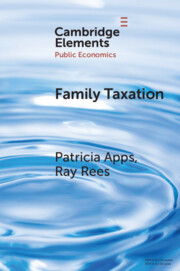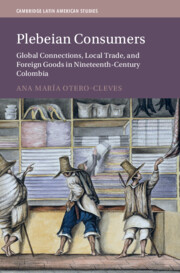Refine search
Actions for selected content:
255 results
10 - Shopping for Shoes: Consumer Identity, Commodity Fetishism, and Gender as a Brand
-
- Book:
- Tied Up in Tehran
- Published online:
- 28 September 2025
- Print publication:
- 16 October 2025, pp 257-293
-
- Chapter
- Export citation
‘Voi e il cinema’. Visual culture, gender and cinema consumption in Fascist Italy (1938–43)
-
- Journal:
- Modern Italy , First View
- Published online by Cambridge University Press:
- 12 September 2025, pp. 1-24
-
- Article
-
- You have access
- Open access
- HTML
- Export citation
Revisiting consumption and income relationship: a vector logistic smooth transition regression modelling
-
- Journal:
- Macroeconomic Dynamics / Volume 29 / 2025
- Published online by Cambridge University Press:
- 10 September 2025, e139
-
- Article
- Export citation
Mandatory pension contributions, household consumption, and savings
-
- Journal:
- Journal of Pension Economics & Finance , First View
- Published online by Cambridge University Press:
- 09 September 2025, pp. 1-24
-
- Article
-
- You have access
- Open access
- HTML
- Export citation
Marketing, Narratives, and Consumer Desire within Auction Catalogs of Cultural Objects
-
- Journal:
- Advances in Archaeological Practice / Volume 13 / Issue 1 / February 2025
- Published online by Cambridge University Press:
- 13 August 2025, pp. 17-30
-
- Article
-
- You have access
- Open access
- HTML
- Export citation
Telecoupled social–ecological systems: the case of avocado in Chile
- Part of
-
- Journal:
- Global Sustainability / Volume 8 / 2025
- Published online by Cambridge University Press:
- 04 July 2025, e23
-
- Article
-
- You have access
- Open access
- HTML
- Export citation

Family Taxation
-
- Published online:
- 21 April 2025
- Print publication:
- 22 May 2025
-
- Element
- Export citation
Introduction
-
- Book:
- The European Art Market and the First World War
- Published online:
- 10 April 2025
- Print publication:
- 17 April 2025, pp 1-10
-
- Chapter
-
- You have access
- HTML
- Export citation
3 - ‘Wartime Cultural Changes’ (1914–1918)
-
- Book:
- The European Art Market and the First World War
- Published online:
- 10 April 2025
- Print publication:
- 17 April 2025, pp 105-145
-
- Chapter
- Export citation
See it to believe it. Experimental evidence on status consumption among the youth
-
- Journal:
- Experimental Economics / Volume 28 / Issue 1 / January 2025
- Published online by Cambridge University Press:
- 14 April 2025, pp. 107-127
-
- Article
-
- You have access
- Open access
- HTML
- Export citation
Optimal decision-making for consumption, investment, housing, and life insurance purchase in a couple with dependent mortality
-
- Journal:
- Annals of Actuarial Science , First View
- Published online by Cambridge University Press:
- 31 March 2025, pp. 1-29
-
- Article
-
- You have access
- Open access
- HTML
- Export citation
China Eats—Innovation, E-Commerce and Food Safety at the Hangzhou Food Forum
-
- Journal:
- Asia-Pacific Journal / Volume 17 / Issue 11 / June 2019
- Published online by Cambridge University Press:
- 14 March 2025, e2
-
- Article
-
- You have access
- Open access
- Export citation
“History in a Wine Glass” - Race, Taste and the Grape: South African Wine from a Global Perspective Paul Nugent. Cambridge: Cambridge University Press, 2024. Pp. 374. $130.00, hardcover (ISBN: 978100918426); $130.00, ebook (ISBN: 9781009204040).
-
- Journal:
- The Journal of African History / Volume 65 / Issue 3 / November 2024
- Published online by Cambridge University Press:
- 19 February 2025, pp. 463-464
-
- Article
- Export citation
3 - The Market
-
- Book:
- Tehran's Borderlines
- Published online:
- 30 January 2025
- Print publication:
- 06 February 2025, pp 38-57
-
- Chapter
- Export citation
Implementing national antimicrobial consumption in Latin America and the Caribbean: opportunities and lessons learned
-
- Journal:
- Epidemiology & Infection / Volume 153 / 2025
- Published online by Cambridge University Press:
- 14 January 2025, e11
-
- Article
-
- You have access
- Open access
- HTML
- Export citation
Introduction
-
- Book:
- Embodied Experience in British and French Literature, 1778–1814
- Published online:
- 19 December 2024
- Print publication:
- 02 January 2025, pp 1-34
-
- Chapter
-
- You have access
- Open access
- HTML
- Export citation
“Faith it, till you make it”: Prosperity Gospel and Spiritual Hustling among Young Pentecostal Christians in Harare
-
- Journal:
- African Studies Review / Volume 67 / Issue 4 / December 2024
- Published online by Cambridge University Press:
- 26 December 2024, pp. 941-966
-
- Article
-
- You have access
- Open access
- HTML
- Export citation
13 - Transformation and Autonomy
- from Part IV - Making Industry Modern
-
- Book:
- Remaking the World
- Published online:
- 29 November 2024
- Print publication:
- 19 December 2024, pp 262-284
-
- Chapter
- Export citation

Plebeian Consumers
- Global Connections, Local Trade, and Foreign Goods in Nineteenth-Century Colombia
-
- Published online:
- 18 December 2024
- Print publication:
- 05 December 2024
1 - Consumers, Citizens, and the Republican Project
-
- Book:
- Plebeian Consumers
- Published online:
- 18 December 2024
- Print publication:
- 05 December 2024, pp 23-51
-
- Chapter
- Export citation
